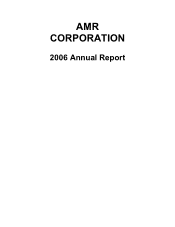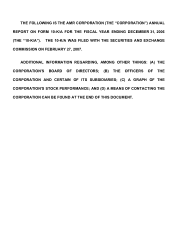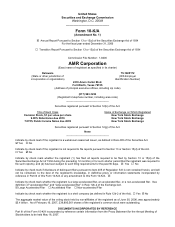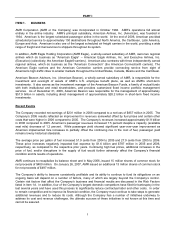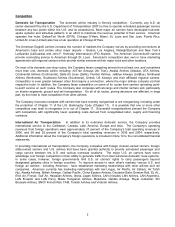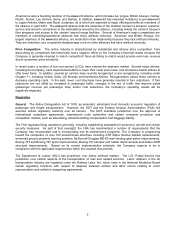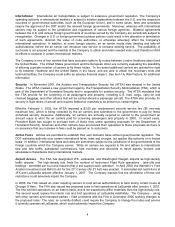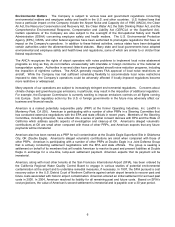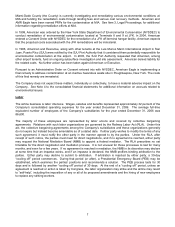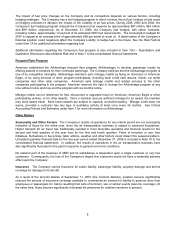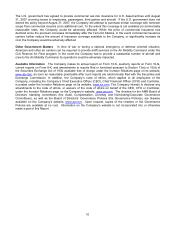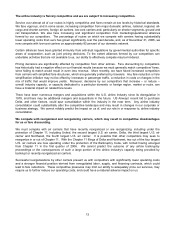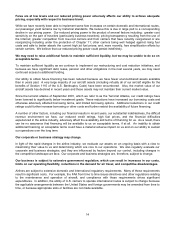American Airlines 2006 Annual Report Download - page 11
Download and view the complete annual report
Please find page 11 of the 2006 American Airlines annual report below. You can navigate through the pages in the report by either clicking on the pages listed below, or by using the keyword search tool below to find specific information within the annual report.
7
Miami-Dade County (the County) is currently investigating and remediating various environmental conditions at
MIA and funding the remediation costs through landing fees and various cost recovery methods. American and
AMR Eagle have been named PRPs for the contamination at MIA. See Item 3, Legal Proceedings, for additional
information regarding remediation efforts at MIA.
In 1999, American was ordered by the New York State Department of Environmental Conservation (NYSDEC) to
conduct remediation of environmental contamination located at Terminals 8 and 9 at JFK. In 2004, American
entered a Consent Order with NYSDEC for the remediation of a JFK off-terminal hangar facility. American expects
that the projected costs associated with the JFK remediations will be immaterial.
In 1996, American and Executive, along with other tenants at the Luis Munoz Marin International Airport in San
Juan, Puerto Rico (SJU) were notified by the SJU Port Authority that it considered them potentially responsible for
environmental contamination at the airport. In 2003, the SJU Port Authority requested that American, among
other airport tenants, fund an ongoing subsurface investigation and site assessment. American denied liability for
the related costs. No further action has been taken against American or Executive.
Pursuant to an Administrative Order on Consent entered into with NYSDEC, American Eagle is implementing a
final remedy to address contamination at an inactive hazardous waste site in Poughkeepsie, New York. The costs
of this final remedy are immaterial.
The Company does not expect these matters, individually or collectively, to have a material adverse impact on the
Company. See Note 4 to the consolidated financial statements for additional information on accruals related to
environmental issues.
Labor
The airline business is labor intensive. Wages, salaries and benefits represented approximately 32 percent of the
Company’s consolidated operating expenses for the year ended December 31, 2006. The average full-time
equivalent number of employees of the Company’s subsidiaries for the year ended December 31, 2006 was
86,600.
The majority of these employees are represented by labor unions and covered by collective bargaining
agreements. Relations with such labor organizations are governed by the Railway Labor Act (RLA). Under this
act, the collective bargaining agreements among the Company’s subsidiaries and these organizations generally
do not expire but instead become amendable as of a stated date. If either party wishes to modify the terms of any
such agreement, it must notify the other party in the manner agreed to by the parties. Under the RLA, after
receipt of such notice, the parties must meet for direct negotiations, and if no agreement is reached, either party
may request the National Mediation Board (NMB) to appoint a federal mediator. The RLA prescribes no set
timetable for the direct negotiation and mediation process. It is not unusual for those processes to last for many
months, and even for a few years. If no agreement is reached in mediation, the NMB in its discretion may declare
at some time that an impasse exists, and if an impasse is declared, the NMB proffers binding arbitration to the
parties. Either party may decline to submit to arbitration. If arbitration is rejected by either party, a 30-day
“cooling off” period commences. During that period (or after), a Presidential Emergency Board (PEB) may be
established, which examines the parties’ positions and recommends a solution. The PEB process lasts for 30
days and is followed by another “cooling off” period of 30 days. At the end of a “cooling off” period, unless an
agreement is reached or action is taken by Congress, the labor organization may strike and the airline may resort
to “self-help”, including the imposition of any or all of its proposed amendments and the hiring of new employees
to replace any striking workers.

